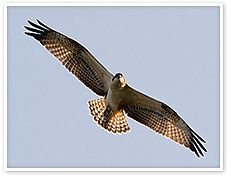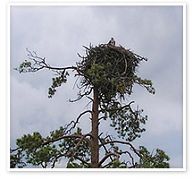Osprey
 The osprey is the smallest of Estonia’s eagles, but also has the most distinctive appearance. Its light lower body, the dark bends of its wings, the multicoloured head and its gull-like appearance when flying help differentiate the osprey from other eagles even without the help of optical instruments. One still has to be observant when identifying the osprey – at the first glance they look remarkably similar to large gulls. Its wing span is 145-160 cm, its body weight is 2 kg for female birds, and about 1.5 kg for male birds. When tracking its prey, the osprey flies in place (hovers in the air) similarly to the common buzzard, the short-toed eagle and the common kestrel. The osprey makes high-pitched squeaking sounds—it is especially vocal when its nest is being disturbed.
The osprey is the smallest of Estonia’s eagles, but also has the most distinctive appearance. Its light lower body, the dark bends of its wings, the multicoloured head and its gull-like appearance when flying help differentiate the osprey from other eagles even without the help of optical instruments. One still has to be observant when identifying the osprey – at the first glance they look remarkably similar to large gulls. Its wing span is 145-160 cm, its body weight is 2 kg for female birds, and about 1.5 kg for male birds. When tracking its prey, the osprey flies in place (hovers in the air) similarly to the common buzzard, the short-toed eagle and the common kestrel. The osprey makes high-pitched squeaking sounds—it is especially vocal when its nest is being disturbed.
Feeding habits
As its Estonian name (literally “the fish eagle”) suggests, our smallest eagle feeds almost entirely on fish. It is probable that the sleeker body of this species has developed during evolution in order to improve its chances of catching fish and makes the osprey better suited for executing moves requiring dexterity. Its more dextrous and faster flight is the osprey’s advantage compared to its larger relatives. However, the osprey can never be sure that the fish it has caught will remain its prey, since in many good hunting grounds, white-tailed eagles have specialised on taking over the ospreys’ catch. Fish are caught from as deep as a meter below the surface, and sometimes, the entire osprey can disappear under water during this process. The osprey’s favoured prey is fish weighing 200-300 grams: it is difficult to fly far with a larger fish and catching smaller ones would be inefficient. The osprey can transport prey to its nest from a distance of over 25 km! Ospreys are everyday visitors at some fish farms and perform the necessary task of removing injured or diseased fish, although healthy fish also fall victim to their attacks. However, when the fish in the ponds grow too large for the birds (over 400 g), the ospreys relocate to other hunting grounds. One osprey needs about 300 g of food per day. If the ospreys reach the final destination of their migration before the ice has melted, or if their nesting period is dominated by especially bad weather, the birds have to either fast or feed on other prey—thus, osprey have also been seen hunting mice and frogs.
Nesting
 The ospreys reach their nesting areas in spring, even before the first bodies of water have been freed of ice. They immediately begin repairing their old nests, or building new ones if the previous nests have not survived the winter. Natural nests are often destroyed by storms—the nests are always located at the tops of trees, and therefore, have no protection against the forces of nature. The nests also collapse due to the fact that the osprey cannot find nesting trees that are strong enough to withstand the winds. To alleviate this problem, eagle enthusiasts have built artificial nests in place of destroyed ones or on nearby trees that are suitable for nesting. Nests built in treetops also have their advantages—the birds can recognise potential danger earlier, flying onto the nest is easier and it is easier for the fledglings to learn to fly. The hen stays with the nest after laying the eggs and it is the task of the male bird to bring enough prey to the nest to feed the hen and the chicks. If you happen to find an eagle’s nest located on top of a tree, like that of a white stork, it probably belongs to an osprey. By the way, in America the osprey usually nests in places preferred by the white stork in Estonia. The osprey lays 2-3 eggs and the hatched chicks usually learn to fly by the end of July. After achieving flight, they still have much to learn about catching their prey, however. Thanks to the environment (primarily bodies of water) being freed of pollution by chlorine organic compound (e.g. DDT), and partly due to the construction of artificial nests, the productivity of Estonia’s ospreys (i.e. the average number of chicks hatched by nesting pairs) is one of the highest in the world.
The ospreys reach their nesting areas in spring, even before the first bodies of water have been freed of ice. They immediately begin repairing their old nests, or building new ones if the previous nests have not survived the winter. Natural nests are often destroyed by storms—the nests are always located at the tops of trees, and therefore, have no protection against the forces of nature. The nests also collapse due to the fact that the osprey cannot find nesting trees that are strong enough to withstand the winds. To alleviate this problem, eagle enthusiasts have built artificial nests in place of destroyed ones or on nearby trees that are suitable for nesting. Nests built in treetops also have their advantages—the birds can recognise potential danger earlier, flying onto the nest is easier and it is easier for the fledglings to learn to fly. The hen stays with the nest after laying the eggs and it is the task of the male bird to bring enough prey to the nest to feed the hen and the chicks. If you happen to find an eagle’s nest located on top of a tree, like that of a white stork, it probably belongs to an osprey. By the way, in America the osprey usually nests in places preferred by the white stork in Estonia. The osprey lays 2-3 eggs and the hatched chicks usually learn to fly by the end of July. After achieving flight, they still have much to learn about catching their prey, however. Thanks to the environment (primarily bodies of water) being freed of pollution by chlorine organic compound (e.g. DDT), and partly due to the construction of artificial nests, the productivity of Estonia’s ospreys (i.e. the average number of chicks hatched by nesting pairs) is one of the highest in the world.
Distribution and numbers
The osprey inhabits almost every continent. Here it nests mainly in Eastern and Southern Estonia and is slowly expanding towards the west. As of 2005, 50-55 pairs of osprey nest in Estonia. As recently as 1985, there were only five known pairs nesting in Estonia, so the number of ospreys has grown 10 times during the last quarter of a century.
Reproductive parameters
The results of the Osprey broods in 2004, 2005 and 2006 are as follows:
| 2004 | 2005 | 2006 | |
|---|---|---|---|
| Number of occupied nests with known breeding results | 35 | 44 | 37 |
| Number of successful nests | 26 | 31 | 29 |
| Nest success (%) | 74 | 71 | 78 |
| Total number of fledglings | 56 | 60 | 61 |
| Mean number of fledglings per occupied nest | 1,6 | 1,36 | 1,65 |
| Mean number of fledglings per successful nest | 2,15 | 1,94 | 2,10 |


